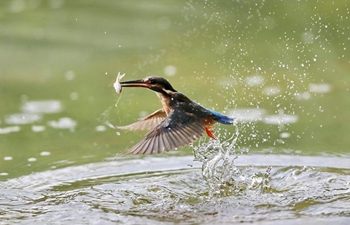by Santosh Ghimire
KATHMANDU, Jan. 1 (Xinhua) -- In 2017, Nepal and China witnessed major developments in the age-old friendly ties while agreeing to further enhance their bilateral cooperation under the framework of the Belt and Road Initiative.
In March 2017, Chinese Defense Minister Chang Wanquan paid a three-day visit to Nepal where the two sides discussed a number of bilateral issues, including maintaining high-level military exchanges, tightening border control, and deepening pragmatic cooperation in various fields.
In the last week of March, Chinese President Xi Jinping met then Nepalese Prime Minister Pushpa Kamal Dahal in Beijing where the two sides agreed to expand bilateral trade and investment, increase connectivity including construction of railways, roads and ports, and enhance cooperation in oil and gas, electricity and clean energy.
In April, the Nepalese Army and People's Liberation Army of China held a first-ever joint military training in Kathmandu, seeking to exchange skills and knowledge on disaster management and counter-terrorism.
In May, a Nepalese high level delegation led by Deputy Prime Minister Krishna Bahadur Mahara attended the Belt and Road Forum for International Cooperation in China, a few days after Nepal joined the Belt and Road Initiative by signing the MoU on Belt and Road cooperation.
Though Nepal witnessed a change of guard in June 2017 as Nepali Congress President Sher Bahadur Deuba became the country's prime minister for the fourth time, the two governments continued their friendly ties based on mutual trust and understanding as earlier.
In August, Chinese Vice Premier Wang Yang met top political leadership in Kathmandu in course of his visit to Nepal, where the two sides agreed to make joint efforts to further advance pragmatic cooperation between the two countries under the framework of the Belt and Road Initiative.
As the two countries are willing to connect each other through the railway connectivity, top officials from China's National Railway Administration (NRA) visited Nepal in November to start groundwork for the development of the proposed railway connecting Kathmandu and Chinese border town Kerung.
In November, Nepalese officials identified three potential infrastructure projects to be implemented under the framework of the Belt and Road Initiative which include a cross-border railway line linking China's Kerung with Nepal's Kathmandu, an electricity transmission line connecting Kerung with Nepal's Galchhi in Dhading district, and a Sunsari-Marin Diversion Irrigation Project in eastern Nepal.
"We support the Belt and Road Initiative and will take an active part in the China-proposed initiative," Nepalese Foreign Secretary Shanker Das Bairagi told Xinhua, stating that his country is willing to earnestly implement the consensus reached between leaders of the two countries in various occasions.
China continued to contribute Foreign Direct Investment (FDI) to Nepal in 2017 as well. In September, the Investment Board Nepal (IBN) and Hongshi-Shivam Cement Private Limited, a Nepal-China joint venture company, signed Project Investment Agreement (PIA) to set up a mega cement factory in Nepal with an investment of 359.18 million U.S. dollars. The agreement was the first of its kind in Nepal for private sector investments.
This was the largest Chinese investment in Nepal's cement industry. The joint venture industry has targeted to start production by 2018 with initial production of 6,000 tons of cement per day. The company which has already started construction of the factory has employed more than 1,000 local workers during its construction period, according to the company. The company is expected to start its cement production from March 2018.
As Nepal successfully completed a transition by holding the elections for local bodies, provincial assemblies and federal parliament in 2017 as outlined in the historic new constitution promulgated in 2015, people are hopeful that the country will enter into an era of political stability and development.
Many in Nepal have high hopes that Nepal and China will see a stronger cooperation between the two countries in 2018 on multiple fields including trade, investment, commerce, rail-road connectivity, energy, tourism and people-to-people contacts.

















